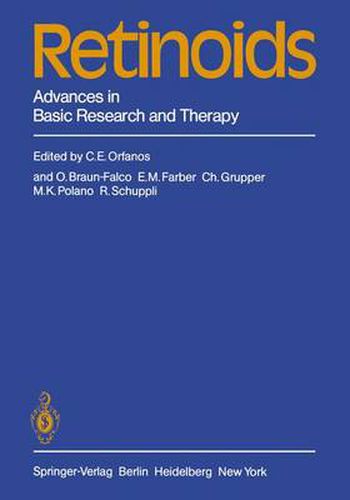Readings Newsletter
Become a Readings Member to make your shopping experience even easier.
Sign in or sign up for free!
You’re not far away from qualifying for FREE standard shipping within Australia
You’ve qualified for FREE standard shipping within Australia
The cart is loading…






This title is printed to order. This book may have been self-published. If so, we cannot guarantee the quality of the content. In the main most books will have gone through the editing process however some may not. We therefore suggest that you be aware of this before ordering this book. If in doubt check either the author or publisher’s details as we are unable to accept any returns unless they are faulty. Please contact us if you have any questions.
With the aromatic retinoic acid analog Tigason oral and intravenous pharmacokinetic studies have been performed in 5 normal volunteers. Simultaneous fitting of single i. v. and oral data to a three-compartment model assuming first-order absorption was possible. Using Nonlin parameter estimates of the single-dose data, one is able to predict the decline in plasma levels of parent drug following cessation of a 10 days multiple dosing regimen up to 24 hours. The model is however unable to predict a phase of prolonged elimination observed beyond 24 hours. Moreover in 5 patients, who underwent chronic therapy (8-15 months), substantial plasma levels of both unchanged drug and main metabolite (corre sponding carboxylic acid) were observed up to 140 days after cessation of the therapy. An apparent half-life of elimination of 80-100 days can be calculated. The drug appears to be stored at some yet unknown storage site. Investigation of metabolism of Tigason in rats and humans revealed 19 different bio transformation products thus far, most of them appearing in the urine in low amounts (20010 of dose). A few of them (mainly the acid Ro 10-1670) after conjugation to glucuronic acid are excreted in the bile in high amounts (60-80% of dose). No drug appeared unchanged in the excreta after i. v. administration to rats. References 1. Bollag W (1971) Effects of vitamin A acid (NSC-122758) on transplantable and chemically-induced tumors. Cancer Chemother Rep 55:53-58 2.
$9.00 standard shipping within Australia
FREE standard shipping within Australia for orders over $100.00
Express & International shipping calculated at checkout
This title is printed to order. This book may have been self-published. If so, we cannot guarantee the quality of the content. In the main most books will have gone through the editing process however some may not. We therefore suggest that you be aware of this before ordering this book. If in doubt check either the author or publisher’s details as we are unable to accept any returns unless they are faulty. Please contact us if you have any questions.
With the aromatic retinoic acid analog Tigason oral and intravenous pharmacokinetic studies have been performed in 5 normal volunteers. Simultaneous fitting of single i. v. and oral data to a three-compartment model assuming first-order absorption was possible. Using Nonlin parameter estimates of the single-dose data, one is able to predict the decline in plasma levels of parent drug following cessation of a 10 days multiple dosing regimen up to 24 hours. The model is however unable to predict a phase of prolonged elimination observed beyond 24 hours. Moreover in 5 patients, who underwent chronic therapy (8-15 months), substantial plasma levels of both unchanged drug and main metabolite (corre sponding carboxylic acid) were observed up to 140 days after cessation of the therapy. An apparent half-life of elimination of 80-100 days can be calculated. The drug appears to be stored at some yet unknown storage site. Investigation of metabolism of Tigason in rats and humans revealed 19 different bio transformation products thus far, most of them appearing in the urine in low amounts (20010 of dose). A few of them (mainly the acid Ro 10-1670) after conjugation to glucuronic acid are excreted in the bile in high amounts (60-80% of dose). No drug appeared unchanged in the excreta after i. v. administration to rats. References 1. Bollag W (1971) Effects of vitamin A acid (NSC-122758) on transplantable and chemically-induced tumors. Cancer Chemother Rep 55:53-58 2.